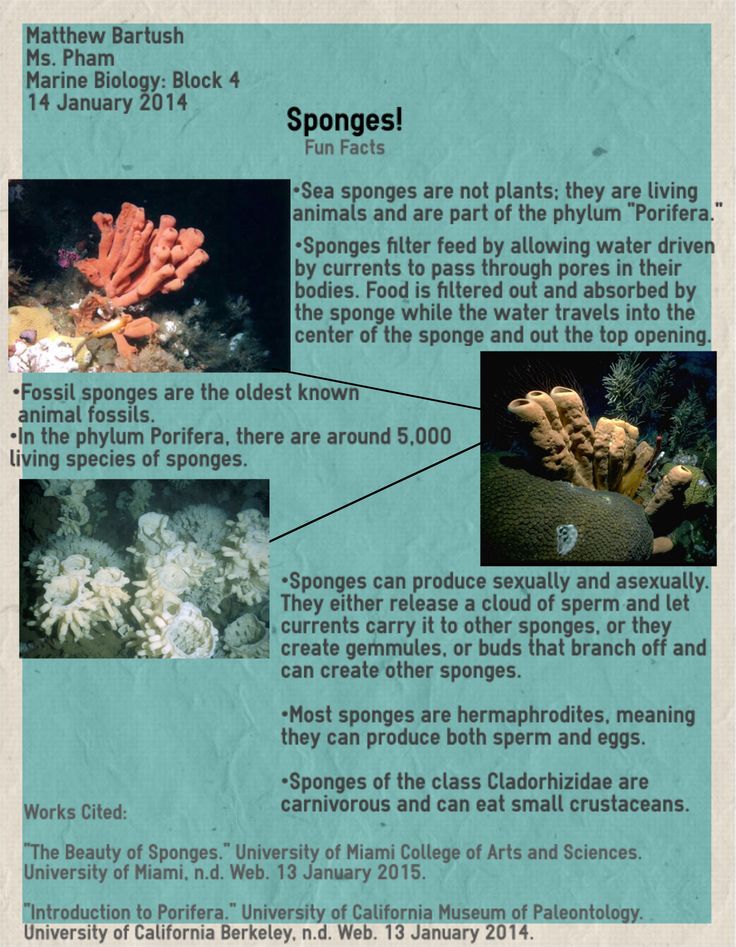Five facts about sponges Early fossil records show that sponges lived on Earth about 600 million years ago. It's a very long time for animals without a complex nervous system, digestive system, or circulatory system! Some deep-sea sponges can live up to more than 200 years ago. The sponge is a master filter. Another interesting fact from the sponge. Sponge has tremendous regenerative power. Sponge has the ability to regenerate lost parts by being blocked by water currents. In addition, sponges have the ability to calmly replenish and grow into clones of their original form. The yellow sponge is ideal for peeling bath sponges, fake finishes, textures, tile and grout work, household and general use. Cleaning project. Yellow sponges are named after their attractive bright gold color and are usually cheaper than wool. Natural Yellow Sea Sponge is a versatile tool with hundreds of uses. Demoponge has a soft body and, in most species, contains a skeleton composed of spicules. These can be composed of calcareous, siliceous, or protein fibers. The configuration may also have some combination of these elements. Most members of this class are leuconoids.
Five Facts About Sponge Early fossil records show that sponge lived on Earth about 600 million years ago. It's been a very long time some deep-sea sponges can live over 200 years ago. The sponge is a master filter. They can filter 100,000 times more water every day! So more
What are the interesting facts about sponges?
Sponge has been inhabiting the sea for 500 million years. 3. The sponge does not move, but filters a lot of water for food (plankton) and oxygen. 4. Sponges are one of the simplest multicellular organisms.
Does the sponge have organs?
The sponge has no organs and is composed of special cells that perform all processes. The household sponge we use is designed by sponge. Some species of sponge are carnivorous and feed on crustaceans and other small animals. They mainly live in the deep sea.
What kind of sponge do you use at home?
The household sponge we use is designed with sponge. Some species of sponge are carnivorous and feed on crustaceans and other small animals. They mainly live in the deep sea. Some deep-sea sponges can live up to 200 years old.
What are the characteristics of demosponge?
Demosponge is often brightly colored and can grow to be the largest of all sponges. Demosponge accounts for more than 90 percent of all living sponge species. Limestone sponges are the only group of sponges that have spicules made of calcium carbonate.
What are the facts about sponges?
They make up the entire phylum of animals, Phylum Porifera. Sponges are some of the simplest multicellular organisms. They do not have heads, eyes, brains, arms, legs, ears, muscles, nerves or organs. There are no organs, but sponges are made up of specialized cells that carry out all biological processes. 2021.
Do the sponges have eyes?
The sponge has no eyes or ears. There is no nose or mouth.
How old is the sponge?
Scientists predict that among the most basic animals, sponges occurred hundreds of millions of years before the outbreak of the oldest confirmed fossil specimens dating back about 500 million years. increase.
Do you have the number of hearts to sponge?
There is no heart, no veins, no arteries, and no blood on the sponge. However, they achieve gas exchange and nutrient consumption through the movement of water. Water is drawn into the sponge through the inner choanocytes, and the inner choanocytes take up water from the outer pores of the sponge.

Below you will find two helpful answers on a similar topic. 👇
What are the symptoms of high blood pressure in dogs?Do ocelots have spots?
